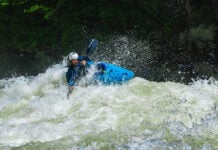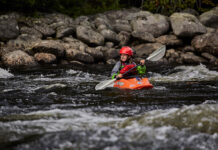Whether you are highly experienced or an occasional weekend warrior, rolling a kayak is an essential skill. We asked 9 expert kayakers to share their most important myths about rolling a kayak, and none of them could quite agree.
9 myths about rolling a kayak
Myth #1: Muscle memory will save you
“Some say it’s like riding a bike—once you’ve learned it, you can just jump back into it at any time. If you’ve been away from kayaking for some time, chances are muscle memory isn’t as strong and you can find yourself swimming.”
— Andy Hill, C1 world champion
Myth #2: Flexibility required
“I have taught classes where the women in the class learn how to roll much faster than the men. The men sometimes get a hurt ego, and play it off as the women being more flexible. Are you flexible enough to lift your arms above your head?
Then you are flexible enough to roll a kayak. You don’t have to be flexible in order to roll. I have seen a stiff 76-year-old man learn to roll, he just needed to find a different technique to do it.”
— Brooke Hess, U.S. National Freestyle Kayak Team
Myth #3: It takes great strength
“People think rolling a kayak is hard. It’s not about strength, it’s more about technique and finesse than anything else.”
— Katie Kowalski, Canoe Kayak Canada National Freestyle Team
Myth #4: Forward or back is better
“The myth is it’s easier and safer to roll up staying forward, or that it is easier to roll up finishing back. Even if the argument is that your face may be exposed, it is safest to be upright. How you get back upright the quickest is the safest.”
— Nick Troutman, pro kayaker
Myth #5: Your roll can disappear
“The myth of the disappearing roll. Sometimes in turbulence, beginners and intermediates find their rolls disappear. They flail and cannot get up. This is because they have practiced their rolls in a certain way, from one starting position, but turbulence forces the boat, their body, and their paddle out of position.
The roll is there, but you must practice doing it with power from any starting point. That’s what is meant by a combat roll. And the myth of the hip snap—people tell beginners to snap their hips during the roll, which is confusing and false. The only place where you exert force on the boat to turn it upright is through the knee pushing in the direction of the roll. You don’t need a hip snap—your hip will follow your knee.”
— Doug Ammons, explorer
Myth #6: Rolling is elementary
“Rolling a kayak is like riding a bike. Truth: Rolling a kayak is only like riding a bike if the bike is upside down and underwater with rocks and trees flying by. Too many times we downplay how difficult a reliable roll is to master or maintain. The secret to the roll is long-time boaters must practice, and beginner kayakers must have patience.”
— Ben Stookesberry, explorer
Myth #7: Some boats are better
“A myth about rolling a kayak is some boats are harder to roll than others. Here’s a fact about rolling—anyone with a good hip snap can roll any appropriately sized kayak. Truth.”
— Stephen Wright, pro kayaker and coach
Myth #8: Pros are perfect
“The myth about rolling is that pro kayakers don’t swim.”
— Rafa Ortiz, pro kayaker









Totally disagree about “myth” some boats are harder to roll is a MYTH. No its TRUE. Not saying you cant roll this boat but I can roll this other boat. I can roll any boat. What i am saying is some roll easier. Greenland style of boat being so low in the water roll like a plank of wood where some high riding boats roll much harder. I get into a friends greenland boat I hand roll it with ease. But have much harder time hand rolling my much higher riding valley boat. I can easily roll with a paddle any of them but all boats dont roll as easy as others. That’s a FACT. I compare boats to see. Then I can say yea that boat rolls easy but this boat rolls harder. I can roll all of them but this one requires more effort.
Myth 6 – You don’t need a hip snap
Myth 7 – anyone with a good hip snap can roll
So which is it, do I need a hip snap or not!
Paddling instruction like other sports instruction has evolved to provide athletes with better cues for performance. Hip snap is a left over term from when boats were lower volume with narrower beams and lower deck heights. This kept the paddler’s legs in a much straighter position with the knees in a much lower position. With modern boats the knee/thigh brace is greatly improved ergonomically (knees more comfortably bent) and creates a more natural ability to feel and drive the knee up into the deck of the boat. Driving the knee up always drives the hip up. Snapping the hip only can result in the hip slipping out of the hip pad with out re-righting the boat.
I have always felt that the term ‘hip snap’ is misleading and confusing for beginners, so I agree with the second paragraph on Myth 5. However, I was then disappointed to read your statement Myth 7 when you state “anyone with a good hip snap can roll any appropriately sized kayak.” That statement reinforces the ‘hip snap myth.’
As an instructor and kayaker for over 30 years, I also take issue with the “myth” that some boats are harder to roll. Which boats are harder will depend on the style of roll that a paddler uses, but some boats will be harder to roll for some paddlers. A high back deck may make it more difficult for someone who uses a Greenland layback roll. A kayak with a cockpit that is too large for the paddler will make it much more difficult, and in some cases impossible, for that paddler to roll. I would also take issue with the “myth #5”. When teaching beginners to roll, it is very common for them to have some success at rolling in flatwater, and then come back two days later and find themselves unable to roll – in flat water. The problem is that when learning, the muscle memory isn’t strongly ingrained and the person is obviously making some mistake that they are unable to diagnose and correct at that time. With time and practice (and perhaps help from another paddler) the roll will come back. Way back when I was learning to roll 25 years ago, I successfully rolled in a borrowed whitewater kayak at my first lesson, and then proceeded to “lose” my roll for several years until I found the right instructor who helped me get it back by putting me in a kayak that was much easier to roll than my own kayak.
to lose your roll for years would suggest you stopped doing your rolls once you started , your roll is all about technique nothing more once you have this mastered you don’t just lose it , thats about the same as riding a bike then not being able too you never got a solid roll
Some boats are harder to roll. Truth
In my view, most of these myths seems true for some people in some circumstances, and not true to others in their different circumstances.
That is very much the “problem” when people discuss about rolling in online forums. Often people only look at it from their own standpoint and don’t consider all the different startpoints that different people have when it comes to flexibility and strength. Yes it matters, as long as you don’t have enough flexibility and strength in all parts of your body for an optimal use of the best possible technique, then you need to adopt your technique to your own conditions if you want the fastest and best result. There is not one way of learning, not one path of learning that is best for everybody.
#1 Muscle memory
Yes and no. You need to practice to some extent before some of it actually stays there, it takes time, and needs to be refreshed. Many of us don’t have the option to stay in the kayak and put that time and effort in until there have elapsed a considerable amount of calendar time. And often you need to trigger the memory by doing some side scull to get your confidence back and rely on your roll. It’s not a yes or no on the question “Can you roll?”, you need to recapture your ability over and over again but it gets easier each time. And it’s not a straight learning curve, it goes up and down but there is a upgoing trend over time.
#2 Flexibility
If you have both flexibility, strength, and a good sculling practice, and combine that with a good timing technique and movement pattern, then you have a solid roll that works even if there is many difficult circumstances like low visibility in air and water, cold water, no nose plug, wind, waves, fatigue in muscles because in the end of a long and tiring outing, a too big volume kayak for you, etc.
If you remove or reduce one or a few of these skills, you also need to remove or reduce a few of the difficulties. If you achieve to roll in the comfy pool, that is a good start but doesn’t assure that it will work in the sea.
#3 Strength
It will help. See point #2. And strength needs to be matched with flexibility. You need some strength at the outer range of your flexibility.
#4 Forward or Back
In shallow river WW or beach surf, yes the back of your head covered with a helmet might be better to turn downwards than your face. If you have the option. If you can’t do a forward-to-forward roll then you need to use what roll you have.
#5 Roll can disappear / Hip snap
Yes the roll can seam to disappear or hide from you, if you haven’t practiced enough for changing conditions and variations. The balance between skills and difficulties, see #2.
I agree about focusing on the knee and let the hip follow.
#6 Rolling is elementary
As I said already, I don’t think there is often that a person sense a distinct moment when you suddenly have a bombproof roll. You get better and more confident over time. You sense steps when you overcome some annoying obstacles and feel that “now you have it”, but next training session you might need to spend most of that session to recapture and find back to that feeling or even fail to get to the same spot until several sessions later.
#7
See #2. Of course the boat can make a difference if you are on the edge of making it. And of course you can roll a variety of boats if you are good enough.
#8
You probably never get fully confident, but you can get to a point where you don’t get out in circumstances where your capabilities are to small for the conditions. If your margins are big enough, you won’t swim. But most people do train on that level because they want to go out in challenging environment, and when pushing the limits, you might swim.
#9
Of course it’s hard. It’s always hard until you get it. And then it might feel easy, sometimes. And then hard again, because of the surging amplitude of the learning curve, and because you push your limits and raise the demands.